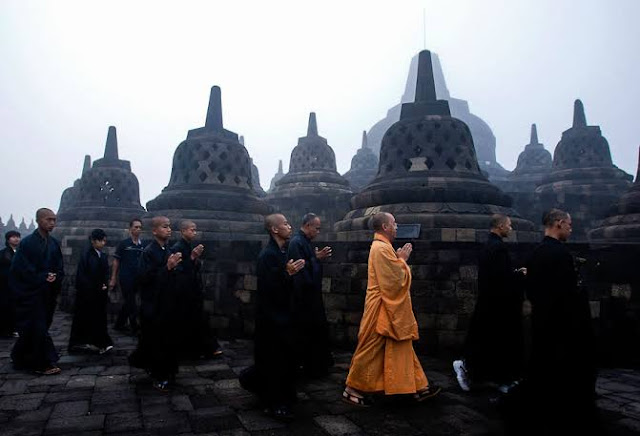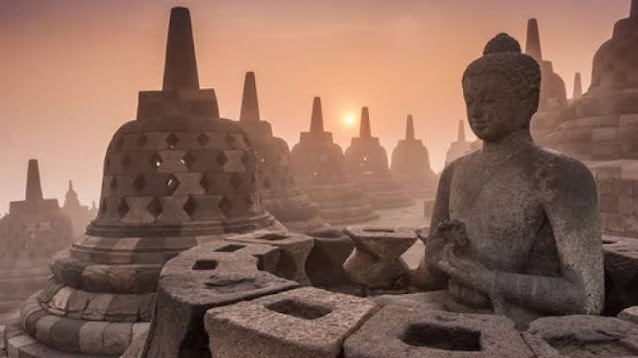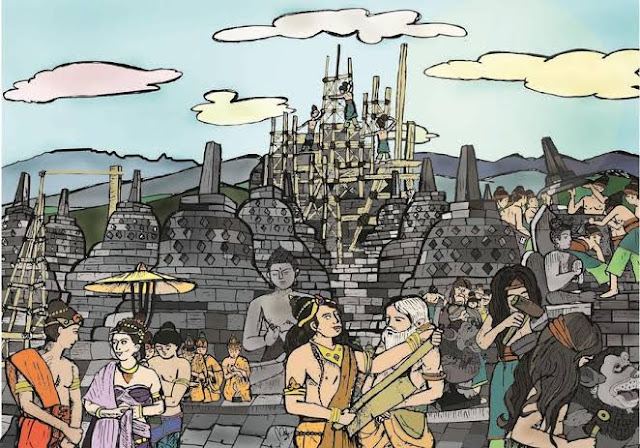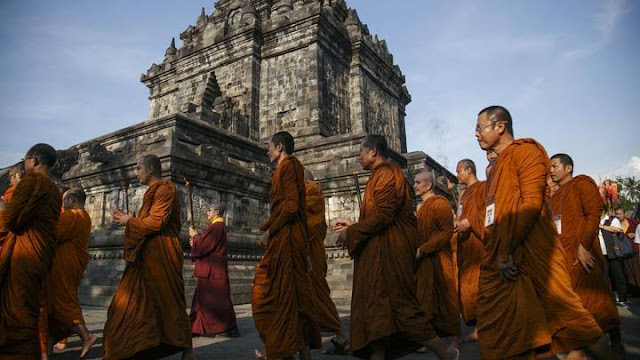The Borobudur History
Borobudur Temple is a Buddhist temple located in Magelang, Central Java, Indonesia. The location of the temple is approximately 100 km to the southwest of Semarang, 86 km to the west of Surakarta, and 40 km to the northwest of Yogyakarta.
 |
| theculturetrip |
Borobudur History
This stupa-shaped temple was founded by Mahayana Buddhists around the year 800 AD during the reign of the Syailendra dynasty. Borobudur is the largest Buddhist temple in the world, as well as one of the largest Buddhist monuments in the world.
The monument consists of six square-shaped terraces on which there are three circular courtyards, the walls are decorated with 2,672 relief panels and originally there were 504 Buddha statues. Borobudur has the most complete and most extensive collection of Buddhist reliefs in the world.
The largest main stupa is located in the center and crowns of this building, surrounded by three circular lines of 72 hollow stupas where there is a Buddha statue sitting cross-legged in a perfect lotus position with the Dharmachakra mudra (turning the dharma wheel).
This monument is a model of the universe and was built as a holy place to honor the Buddha and also serves as a place of pilgrimage to guide mankind to move from the world of lust to enlightenment and wisdom according to Buddha's teachings. Pilgrims enter via the eastern side to begin the ritual at the temple grounds by walking around the sacred building in a clockwise direction, while continuing to ascend to the next step through the three levels of realm in Buddhist cosmology.
The three levels are Kamadhtu (realm of passion), Rupadhatu (realm of form), and Arupadhatu (realm of form). On this journey pilgrims walk through a series of aisles and stairs watching no less than 1,460 exquisite relief panels carved into the walls and balustrades.
According to historical evidence, Borobudur Temple was abandoned in the 14th century when the influence of the weakening of the Hindu and Buddhist kingdoms on Java and the start of Islamic influence. The world began to realize the existence of this building since it was discovered in 1814 by Sir Thomas Stamford Raffles, who at that time served as the Governor General of England in Java.
Since then Borobudur has undergone a series of rescue and restoration efforts. The largest restoration project was held in the period 1975 to 1982 under the efforts of the government of the Republic of Indonesia and UNESCO, so this historic site was included in the list of World Heritage Sites.
 |
| khmertimes |
Borobudur is still used as a place of religious pilgrimage. Every year Buddhists who come from all over Indonesia and abroad gather at Borobudur to commemorate Vesak Trisuci. In the world of tourism, Borobudur is the only tourist attraction in Indonesia which is most visited by tourists.
Borobudur History
Borobudur Stupa with Menoreh Hill. For centuries this sacred building was forgotten.
In Indonesia, ancient religious buildings are called temples, the term candi is also used more broadly to refer to all ancient structures dating from the Hindu-Buddhist period on the islands, for example gates, gates, and petirtaan (ponds and showers).
 |
| suara |
The origin of the name Borobudur is unclear, although the real names of most temples in Indonesia are unknown. The name Borobudur Temple was first written in the book History of Java by Sir Thomas Raffles. Raffles wrote about a monument called Borobudur, but no older document mentions the exact same name.
The only ancient Javanese text that provides clues about the existence of a Buddhist holy building that may refer to Borobudur is Nagarakretagama, written by Mpu Prapanca in 1365.
The name Bore-Budur, which was later written by BoroBudur, was probably written by Raffles in English grammar to refer to the village closest to the temple, namely Desa Bore (Boro). Most of the temples are often named after the village in which they stand. Raffles also suspected that the word Budur might be related to the Javanese term Buda which means ancient which means ancient Boro. However, other archaeologists think that the name Budur comes from the term bhudhara which means mountain.
Many theories attempt to explain the name of this temple. One of them stated that this name may have come from the word Sambharabhudhara, which means mountain (bhudara) where the slopes are located on the terraces.
Apart from that there are several other folk etymologies. For example, the word borobudur comes from the word of the Buddhas which due to the change in sound became Borobudur. Another explanation is that this name comes from the two words coal and beduhur.
The word bara is said to come from the word monastery, while there is also another explanation where bara comes from Sanskrit which means temple complex or monastery and beduhur means high or reminiscent of Balinese which means above. So the intention was a monastery or boarding house located on the high ground.
Borobudur History
 |
| jalanmille |
Historian J.G. de Casparis on his dissertation to get a doctorate in 1950 argued that Borobudur was a place of worship. Based on the Karangtengah and Tri Tepusan inscriptions, Casparis estimates that the founder of Borobudur was the king of Mataram from the Syailendra dynasty named Samaratungga, who carried out the construction around 824 AD.
Borobudur development is estimated to take half a century. The Karangtengah inscription also mentions the giving of sima (tax free land) by Kahulunan (Pramudawardhani) to preserve KamIn which is called Bhmisambhra.
The term Kamln itself comes from the initial word which means place of origin, a sacred building to honor the ancestors, perhaps the ancestors of Bhmisambhra. Casparis estimates that Bhmi Sambhra Bhudhra in Sanskrit which means the hill of ten levels of bodhisattva virtue is the original name of Borobudur.
Borobudur History
Borobudur, Pawon, and Mendut are located in a straight line which shows the unity of the symbols
Located about 40 kilometers (25 miles) northwest of Yogyakarta city, Borobudur is situated on a hill on a plain surrounded by two pairs of twin mountains, Mount Sindoro-Sumbing to the northwest and Merbabu-Merapi to the northeast, to the north there is Bukit Tidar, more near to the south there is Menoreh Hills.
Borobudur Temple is located near the confluence of two rivers, namely the Progo River and the Elo River in the northeast. According to Javanese legend, the area known as the Kedu plain is a place that is considered sacred in Javanese belief and is called the 'Taman Pulau Jawa' because of its natural beauty and soil fertility.
 |
| tempo |
Borobudur History
Apart from Borobudur, there are several Buddhist and Hindu temples in this area. During the discovery and restoration of the early 20th century other Buddhist temples were discovered, namely the Mendut and Pawon Temples which stretch in a straight line.
Initially this was considered a coincidence, but based on local folklore, there used to be a stone-paved road lined with balustrades on both sides connecting the three temples. There is no physical evidence of the existence of a highway lined with rocks and fenced in, and maybe this is just a fairy tale, but experts suspect there really is a symbol of the union of the three temples.
These three temples (Borobudur-Pawon-Mendut) have similar architectural and decoration styles and are indeed from the same period which reinforces the suspicion of a ritual relationship between the three temples. A sacred relationship must exist, but how the religious pilgrimage is carried out is not known with certainty.
Apart from Mendut and Pawon Temples, around Borobudur, several other ancient relics were also found, including various pottery findings such as pots and jugs which indicate that around Borobudur there used to be several residential areas. Archaeological discoveries around Borobudur are now kept at the Karmawibhangga Borobudur Museum, which is located north of the temple next to the Samudra Raksa Museum.
Not far north of Candi Pawon, the ruins of a former Hindu temple called the Banon Temple were found. In this temple, several statues of the main Hindu deities are found in quite good condition, namely Shiva, Vishnu, Brahma, and Ganesha. However, so few original stones found at Banon Temple have made reconstruction impossible.
When found, the Banon statues were transported to Batavia (now Jakarta) and are now kept at the National Museum of Indonesia. Unlike other temples which are built on flat land, Borobudur is built on a hill at an altitude of 265 meters above sea level and 15 meters above the bottom of an ancient lake which has dried up.
The existence of this ancient lake became a matter of heated debate among archaeologists in the 20th century and raised suspicions that Borobudur was built on the shore or even in the middle of the lake. In 1931, an artist and expert on Hindu Buddhist architecture, W.O.J. Nieuwenkamp, put forward a theory that the Kedu plain was once a lake.
Borobudur History
Borobudur symbolizes the lotus flower floating on the surface of the lake. A lotus in the form of a lotus (red lotus), utpala (blue lotus), or kumuda (white lotus) can be found in all Buddhist religious art iconography, often held by Bodhisattvas as laksana (symbol of greatness), as the basis for sitting on the Buddha's throne. or as a base for a stupa.
The architectural form of Borobudur itself resembles a lotus flower, and Buddhist postures in Borobudur symbolize the Lotus Sutra, which are mostly found in Buddhist texts from the Mahayana school (a Buddhist school which later spread to East Asia). The three round courtyards at the top of Borobudur are also thought to symbolize the lotus petals.
However, Nieuwenkamp's theory that sounds extraordinary and fantastic has drawn objections from archaeologists. In the land around this monument, archaeological evidence has been found which proves that the area around Borobudur during the construction of this temple was dry land, not an ancient lake base.
Meanwhile geologists actually supported Nieuwenkamp's view by pointing out evidence of lake sedimentation near the site.